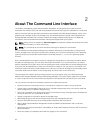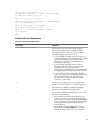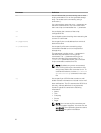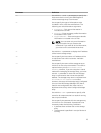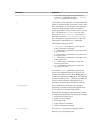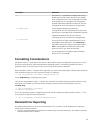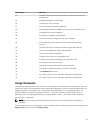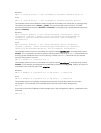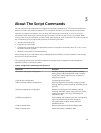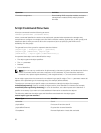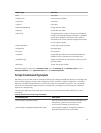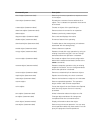
Parameter Definition
-v
Use with the -d parameter to display the current
global status of the known devices in the storage
array configuration file. (The configuration file lists
all of the devices in a storage array configuration
and the relationship between the devices. Use the
configuration file to reconstruct a storage array).
-X (uppercase)
Use to delete a storage array from the
configuration file. (The configuration file lists all of
the devices in a storage array configuration and the
relationship between the devices. Use the
configuration file to reconstruct a storage array).
-x (lowercase)
Use to remove an SNMP trap destination or an e-
mail address alert destination. The community is
the SNMP community name for the trap, and the
host is the IP address or DNS host name of the
system to which you want the trap sent.
-?
Use this parameter to display usage information
about the CLI commands.
Formatting Considerations
Quotation marks (" ") used as part of a name or label require special consideration when you run the CLI
and script commands on a Microsoft Windows operating system. The following explains the use of
quotation marks in names while running CLI and script commands on Windows.
When quotation marks (" ") are part of an argument, you must insert a backslash (\) before each quotation
mark character unless you are in interactive mode. For example:
-c "set storageArray userLabel=\"Engineering\";"
where, Engineering is the storage array name.
You cannot use quotation marks (" ") as part of a character string (also called string literal) within a script
command. For example, you cannot enter the following string to set the storage array name to
"Finance"Array:
-c "set storageArray userLabel=
\"\"Finance\"Array\";"
On a Linux operating system, the delimiters around names or labels are single quotation marks (‘ ’). The
Linux versions of the previous examples are:
-c ‘set storageArray userLabel="Engineering";’
Detailed Error Reporting
Error data collected from an error encountered by the CLI is written to a file. Detailed error reporting
under the CLI works as follows:
• If the CLI must abnormally end execution or abort script command execution, error data is collected
and saved before the CLI aborts.
25




